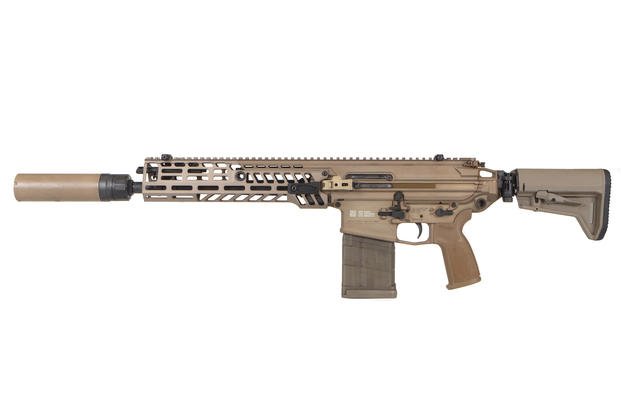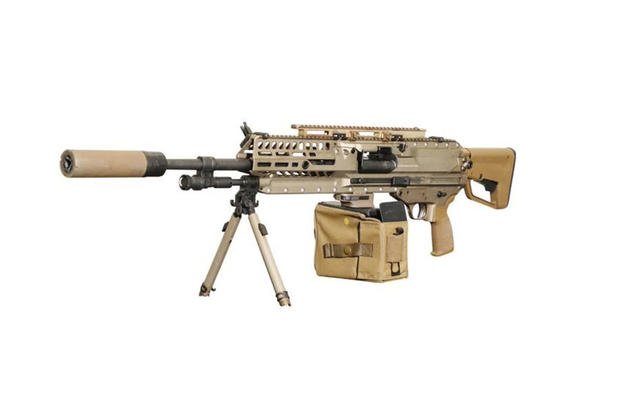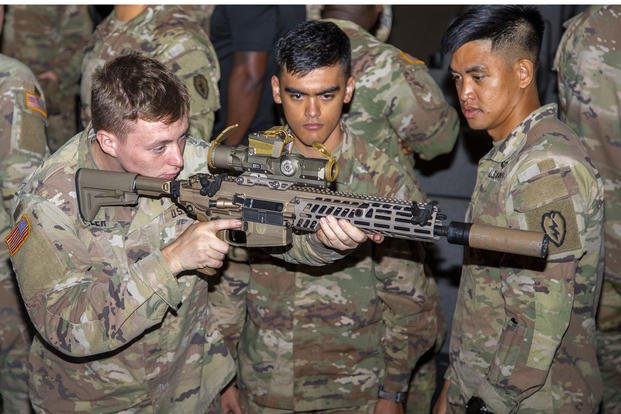The Army has officially fielded its brand-new Next Generation Squad Weapon rifles to its first unit, bringing an end to the service's decades-long effort to replace its M4 and M16 family of military firearms.
Army Futures Command announced Thursday that soldiers from 1st Battalion, 506th Infantry Regiment, 101st Airborne Division, at Fort Campbell, Kentucky, accepted delivery of the XM7 Next Generation Rifle and XM250 Next Generation Automatic Rifle ahead of training in April.
Produced by firearm maker Sig Sauer, the XM7 is intended to replace the M4 carbine in close combat formations, while the XM250 will replace the M249 Squad Automatic Weapon, or SAW. Both new rifles are chambered in 6.8 mm to provide improved range and lethality against enemy body armor.
Read Next: 2 Fort Carson Soldiers Injured in Second Apache Helicopter Crash in 48 Hours
The Next Generation Squad Weapon series also includes the XM157 Fire Control smart scope, built by Vortex Optics, which integrates advanced technologies such as a laser range finder, ballistic calculator and digital display overlay into a next-generation rifle optic.
The fielding "is a culmination of a comprehensive and rigorous process of design, testing and feedback, all of which were led by soldiers," Col. Jason Bohannon, manager of soldier lethality for the Program Executive Office Soldier project, said in a statement. "As a result, the Army is delivering on its promise to deliver to soldiers the highest-quality, most-capable small-caliber weapons and ammunition."

Based on Sig Sauer's MCX-Spear rifle, the XM7 features a 13-inch barrel, both standard and left-side non-reciprocating charging handles, a collapsible buttstock, a free-floating reinforced M-LOK handguard, and AR-style ergonomics. The XM250, based on Sig's LMG 6.8 mm machine gun, features quick-detach magazines and increased M1913 rail space. Both weapons come with Sig Sauer suppressors designed to reduce the blowback from toxic fumes.
Soldiers should know that the XM7 is noticeably heavier than the M4 carbine -- 9.8 pounds suppressed in a basic combat load compared to the M4's 7.4-pound combat load, per the Army -- and delivers increased recoil compared to the M4 on par with a weapon system chambered in 7.62 mm, according to Sig Sauer officials.
According to the Army's fiscal 2025 budget request, the service has a long-term plan of buying 111,428 XM7 rifles, 13,334 XM250 automatic rifles, and 124,749 XM157 Fire Control devices stretching into the 2030s.
The XM7 and XM250 "ensure increased lethality against a broad spectrum of targets beyond current/legacy weapon capabilities; increased range, accuracy, and probability of hit; reduced engagement time; suppressed flash/sound signature; and improved controllability and mobility," the Army's budget says.

The service has been pushing for a new family of infantry rifles since the mid-1980s when it kicked off the Advanced Combat Rifle, or ACR, program to identify a replacement for the M16 family of assault rifles. The canceled ACR program was followed by the XM29 Objective Individual Combat Weapon program in the 1990s and the XM8 assault rifle effort of the early 2000s, both of which were also abandoned.
The M4/M16 replacement effort took on new urgency during the war in Afghanistan, where American soldiers found that the M16 family of rifles and their standard-issue 5.56 mm ammunition -- designed for the close-quarters combat of Vietnam and well-suited for urban warfare during the U.S.-led invasion of Iraq -- proved ineffective against Afghan insurgents engaged at longer distances amid the country's mountainous terrain, as The Associated Press reported in 2010.
That issue led to the 2010 fielding of the upgraded 5.56 mm cartridge, the M855A1 Enhanced Performance Round, as a temporary solution to bolster U.S. troops' lethality in Afghanistan. Eventually, the Defense Department's 2017 Small Arms Ammunition Configuration Study determined that an intermediate 6.8 mm cartridge would likely outperform both standard-issue 5.56 mm and 7.62 mm rounds, inducing the Army to establish the Next Generation Squad Weapon program in 2018 to replace both the M4 carbine and the M249 in its arsenal.
From there, the Army selected three gunmakers to furnish the service with prototypes of the NGSW-Rifle (the M4 replacement) and the NGSW-Automatic Rifle (the M249 replacement): General Dynamics-OTS Inc., AAI Corporation Textron Systems and Sig Sauer, the last of which had won the Army's Modular Handgun System program contract in 2017 to replace the M9 Beretta across every service in the U.S. armed forces.
Sig Sauer eventually clinched the contract in 2022. Since then, the Army has been conducting ongoing user testing on the rifles, putting them through their paces in extreme environments. In late March, days before revealing the initial fielding to 1st Battalion, 506th Infantry Regiment, the service announced plans to build a 6.8 mm ammunition plant in Missouri to support the proliferation of the weapons across the force.
According to the Army, soldiers have spent more than 25,000 hours testing the next-gen weapons from initial development to fielding.
"The process of developing and fielding new equipment is never without challenges and setbacks and speed bumps, so we're celebrating the fact that we're delivering on schedule, as promised," Lt. Col. Mark Vidotto, the program lead for the Soldier Lethality Cross-Functional Team at Fort Moore, Georgia, said in a statement.
Related: Army Aims to Buy 29,000 Next-Gen Rifles and Machine Guns for Grunts to Test













